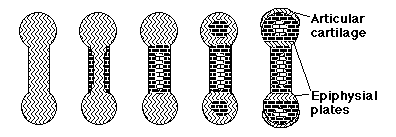Salivary glands: formed as epithelial outfoldings
Pharyngeal pouches:
-
I. Eustachian Tube
II. Tonsils
III. Thymus and Parathyroid glands
(the following is not a misprint) IV. Thymus and Parathyroid glands
Lungs:
trachea; bronchi; alveoli (in mammals) (air capillaries in birds)
Hepatic diverticulum (--> liver) gallbladder
Pancreas
Cloaca --> Bladder (these separate in mammals)
--> Rectum
Birds, reptiles & amphibia continue to have cloacas
In amphibian embryos, the anus develops from the blastopore.
But in reptiles birds and mammals, there is no blastopore.
Instead, they form a posterior infolding called the proctodeum.
This fuses with and then opens into the rear of the archenteron
The proctodeum is an infolding of the somatic ectoderm, equivalent to the stomodeum at the other end.
*******************************************************************************
Skeleton: Bone compared with Cartilage
Bone is stronger and more rigid, but can grow only by surface deposition.
Cartilage is lighter, flexible, not as strong, but can grow by internal swelling (& also by surface addition).
The support of your ears and tip of your nose are elastic cartilage, which is more flexible than hyaline cartilage which constitutes most of the rest of the cartilage.
In some vertebrates (sharks and salamanders) the skeleton is mostly made of cartilage (instead of bone).
Much of this cartilage becomes calcified and can be quite stiff and strong (but weaker than bone).
The
articular cartilages serve for what amounts to lubrication.
They feel and look somewhat like sheets of wet teflon.
Bone formation is called ossification. During embryonic development of mammals and birds (including humans), nearly all the "bones" start out being made of cartilage.
In other words, when you were an embryo, your femur, pelvis, radius, ulna, etc. were all made out of cartilage instead of bone. Only certain skull bones, especially the flat ones, are made out of bone from the very beginning. Later, during development, little-by-little, and continuing up to about age 20, this cartilage is dissolved and replaced by bone. NOTE: the cartilage isn't changed into bone; the cartilage is replaced by bone.

Replacement of cartilage by bone used to be considered as a recapitulation Now it is believed that bone evolved before cartilage, and that replacement is a means of allowing growth. Bones that undergo this process are called " replacement bones"; = endochondral bone
The term " dermal bone" refers to those (skull roof, etc.) bones that are made of bone from the start.
The last parts to ossify are the
epiphysial plates; when they ossify, the bone can't grow any longer.
(Rabbits, chickens, etc. just have an epyphysis instead of a plate)
Up to around 20-21, the age of a skeleton at death can be dated within +/- a few months by noticing which epiphysial plates had "closed" and which ones had not Ossification is very stereotyped.
Mutations in certain genes can cause premature ossification "closure" of epiphysial plates. Basset hounds and dachshunds have short legs because of this type of mutation; also breeds of sheep.
So-called "chondroplastic dwarfism" in humans results from an equivalent (dominant!) mutation.
(no one knows what protein these genes normally code for: an enzyme?)
During the healing of broken bones, bone around the break is dissolved, cartilage is formed in its place, and then this cartilage is gradually replaced by bone, as occurred during development!
Ossification is somehow caused by a special kind of cells called "
osteocytes". But no one really knows for sure exactly what it is that these cells do that causes the bone to form next to them!
They do secrete the collagen, and other materials, but they do not secrete the calcium salts.
Another cell type is specialized for destroying bone; these are multinucleate and called " osteoclasts", that secrete acidic solutions as well as collagen digesting enzymes.
Living bone is a very dynamic tissue, constantly being broken down by osteoclasts and re-deposited by osteocytes.